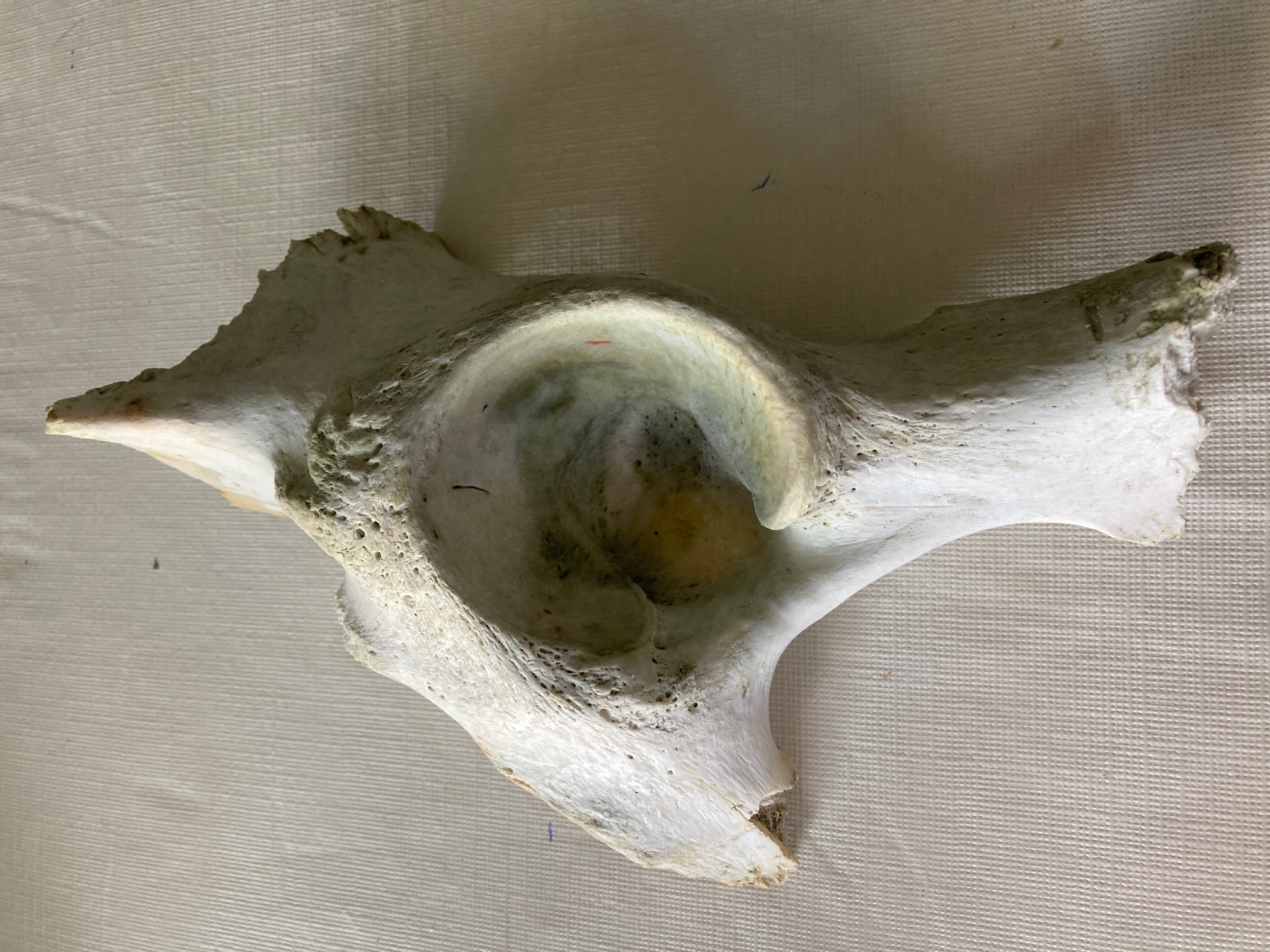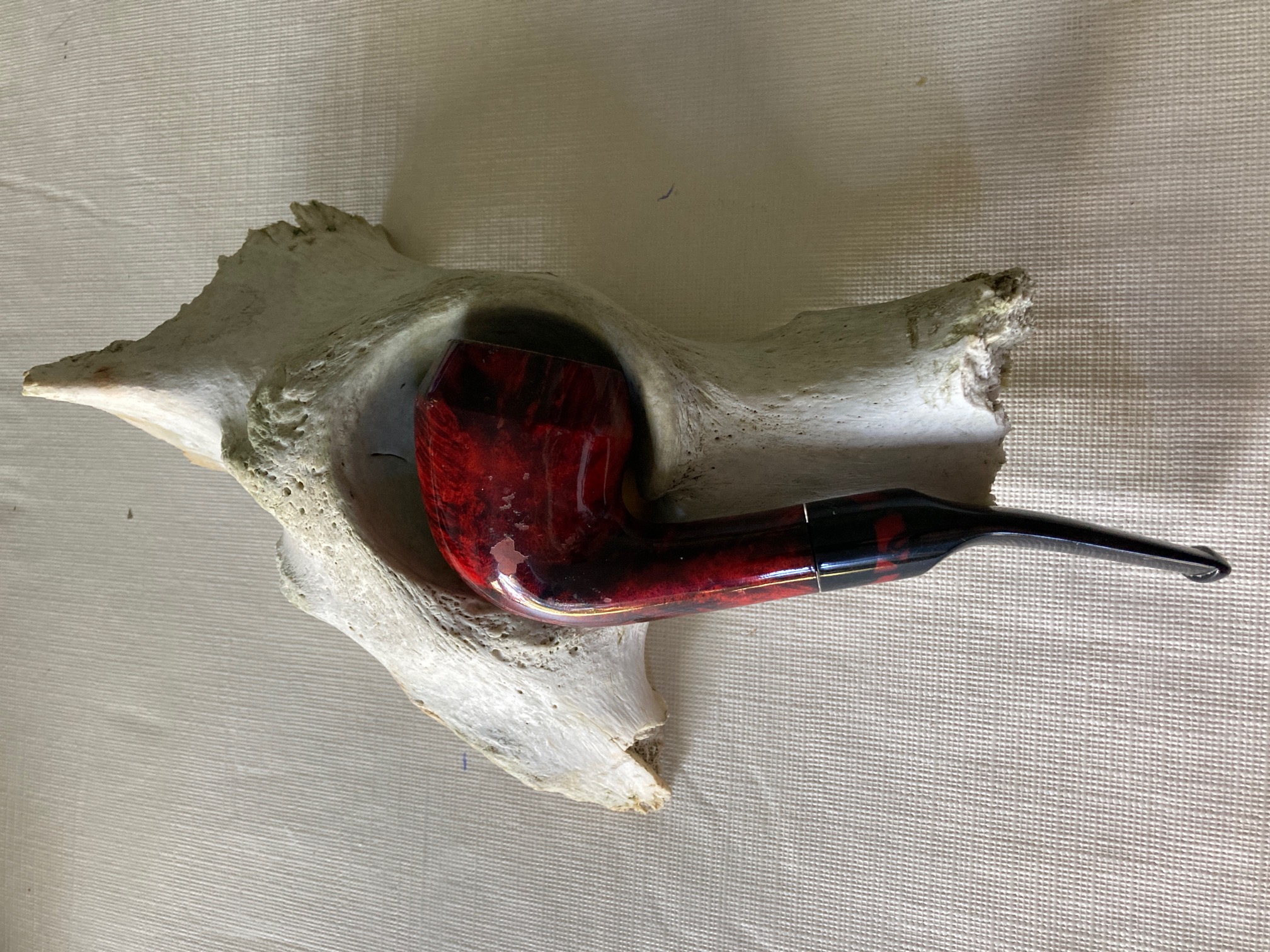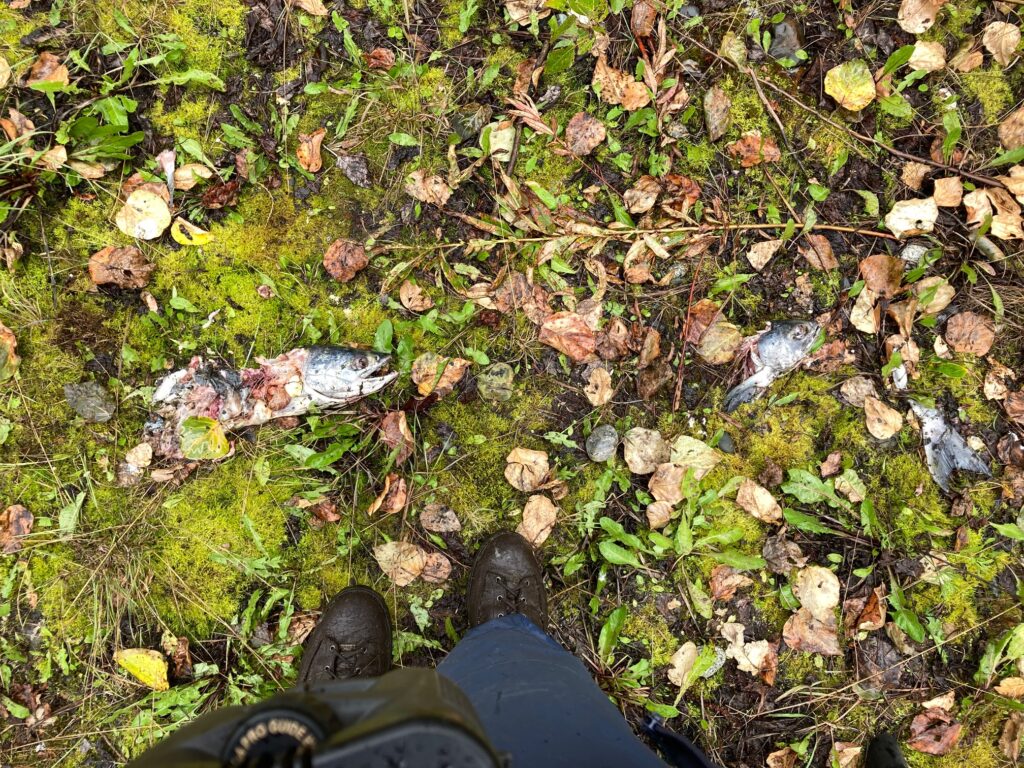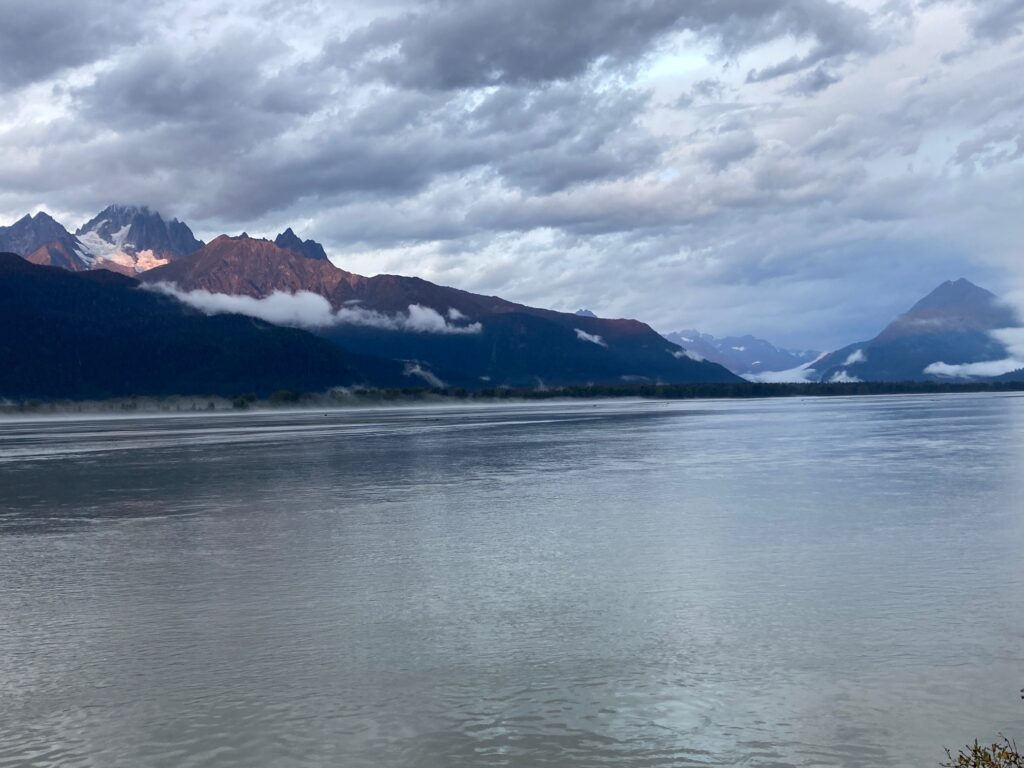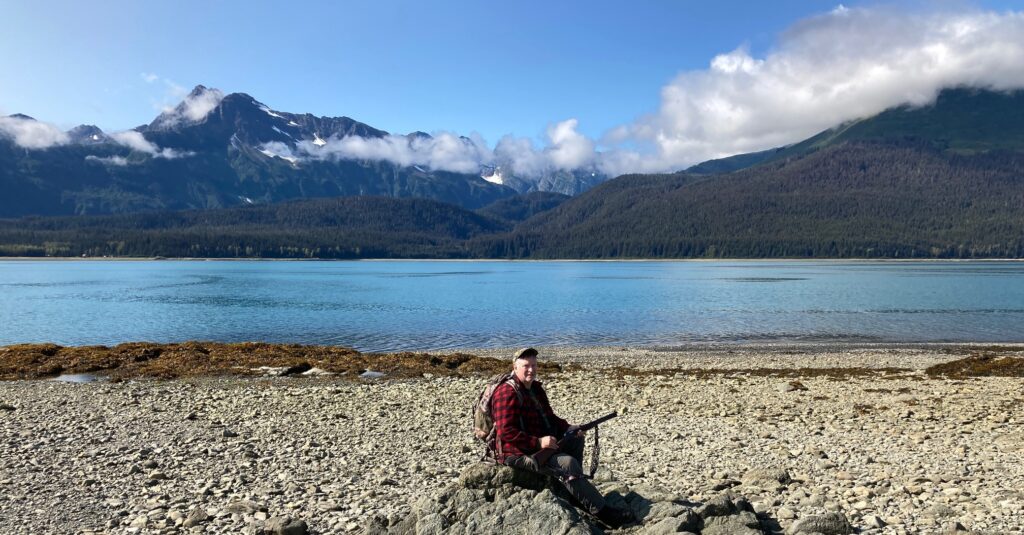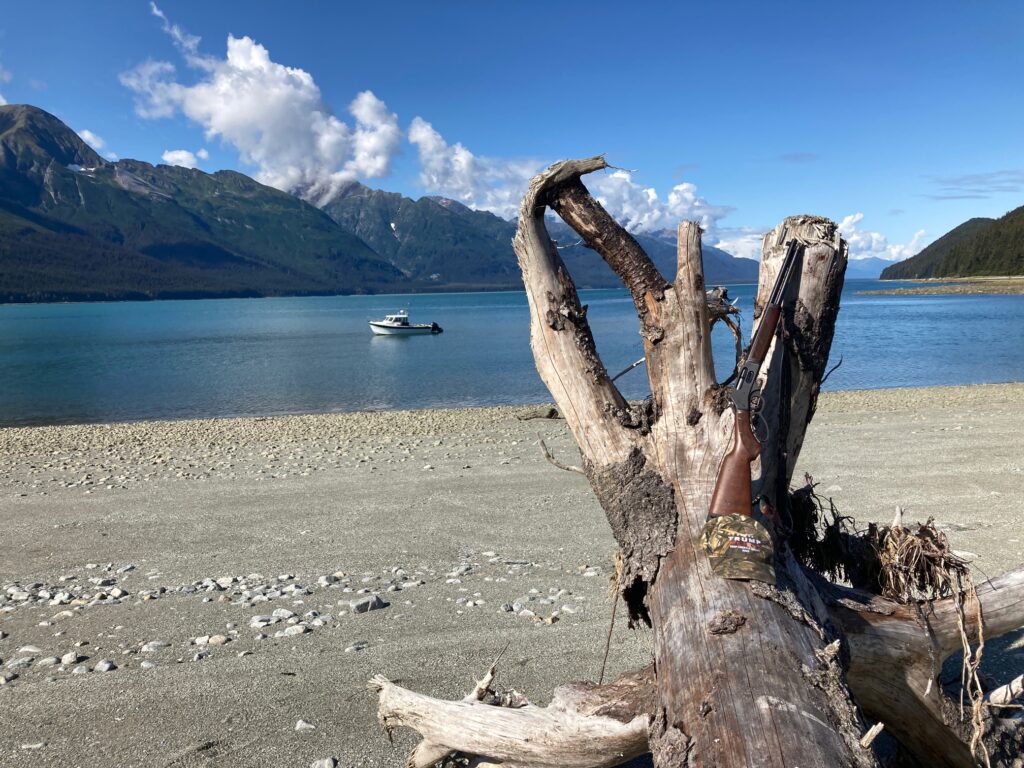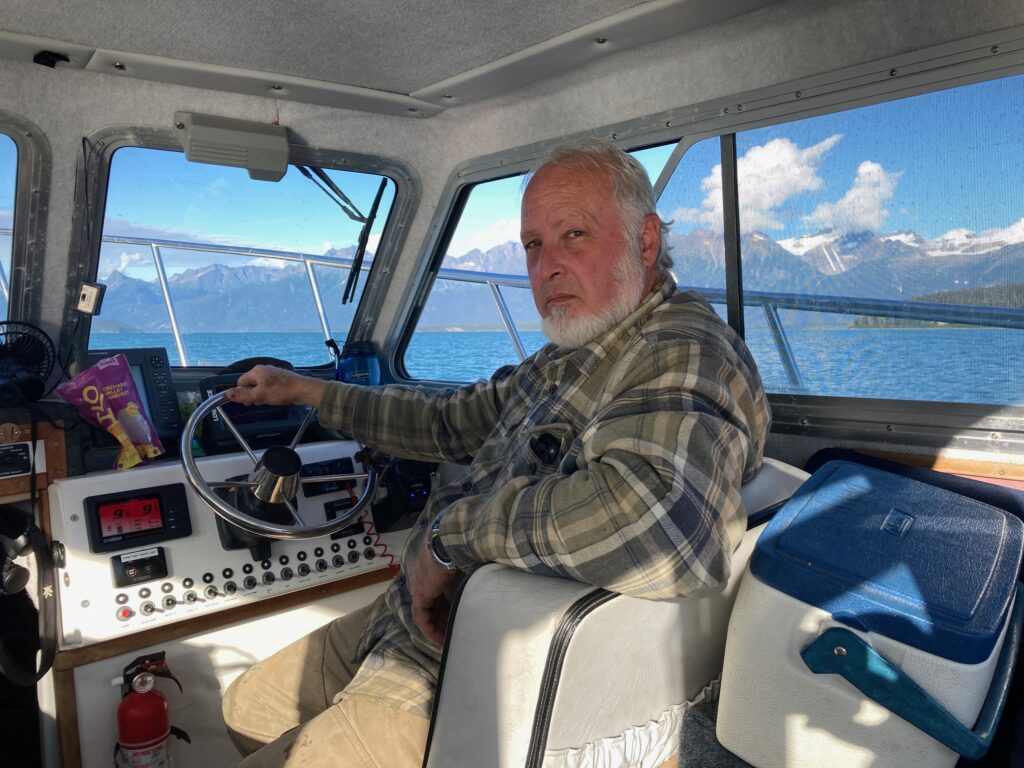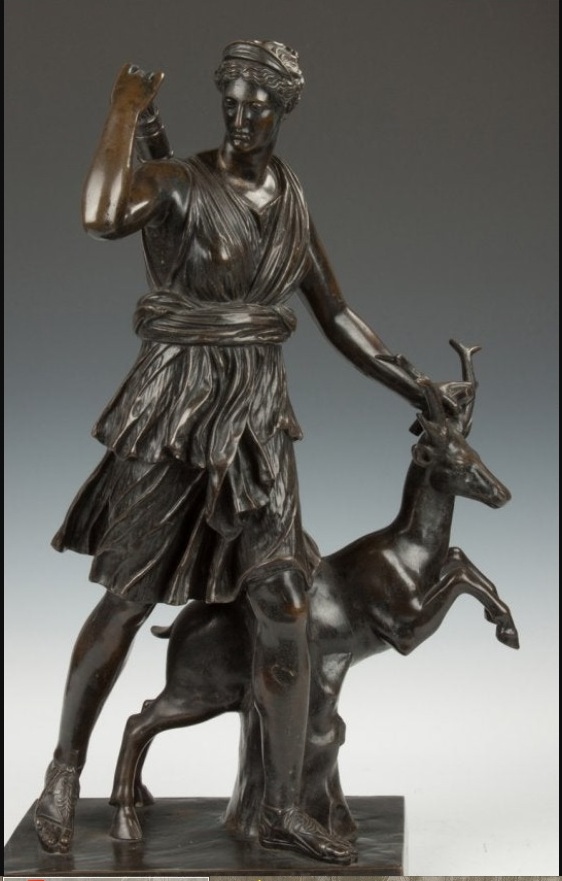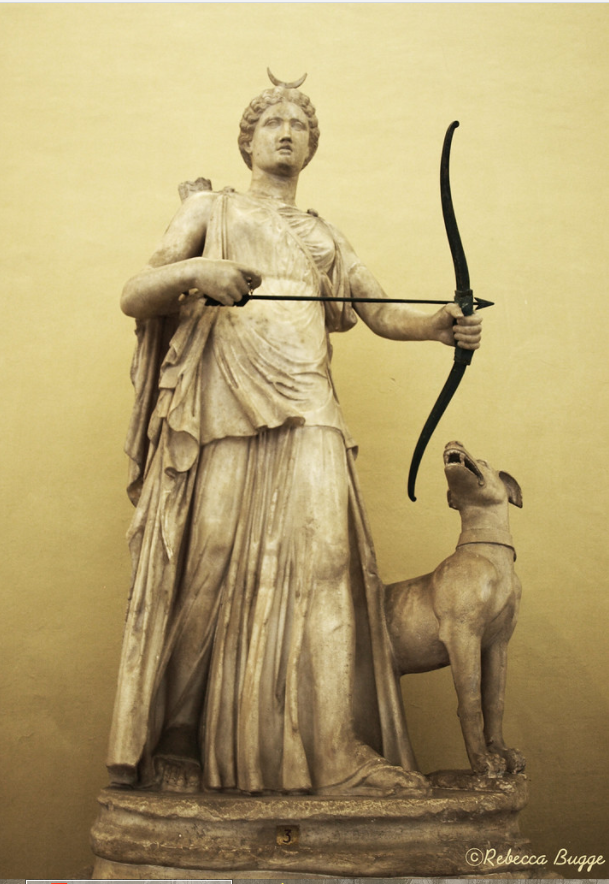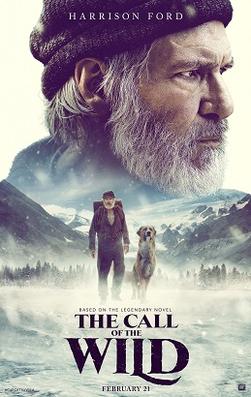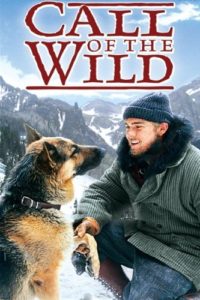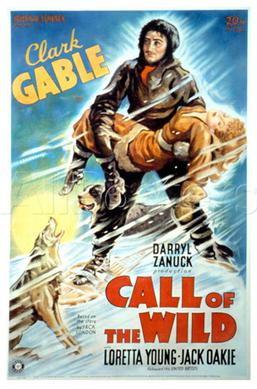Posts Tagged → wilderness
A fabulous hunting trophy
Another PA archery season over (UPDATE: No, it wasn’t over, I have not kept up with new PA archery season dates), another season I did not arrow a deer or a bear. It’s not that I could not have killed a buck with a gigantic rack, I could have, a hundred times. It is that I chose not kill him. He isn’t necessarily tame, but he has been hanging around an awful lot. It would have been easy to send an arrow or a bolt through him from a porch or an upstairs window. But in my old-er age, I must be turning soft-hearted. He even came into a ground blind I was in with a crossbow, and puttered around. I decided to admire him, instead.
Just seeing wild beauty like his brings me real pleasure. I don’t need to put his head on the wall for him to make me happy.
Even without killing a black bear or a wolf, I still got an amazing trophy from my Alaska hunt in September. And no, I am not referring to the beautiful stones and colorful pebbles I bring home with me as keepsakes from all around the world. Alaska streambeds were loaded with all kinds of incredible geological samples, and I could have easily filled a pickup truck bed with the easy ones. Instead, I picked up a memento of someone else’s kill, and brought that home with me.
While I was stalking a salmon stream in the northernmost part of southeast Alaska eight weeks ago, cradling a 45-70 rifle in my arms and looking for black bear feeding on spawning fish with one eye, or a wolf, and watching out for the ever-present brown bears/grizzlies with the other eye, I happened upon a scattering of big bones up against a stream bank. Bleaching white on the top side, and staining green with algae and moss on the bottom side, these bones marked a kill site. From what I could piece together, a two-year-old moose had made a stand against a pack of wolves or a large grizzly on this site, and had lost. It was right here where he had died and had been eaten.
One bone in particular caught my eye, the hip socket, sitting concave-side-up to the sky. What made this individual bone stand out so much was both how perfectly round it was, and yet how it was also framed on three sides by heavily fragmented and fractured ends of bone. Something really big had broken this heaviest of bones, and the tooth marks are still on the socket. As artists are fond of saying about something that catches all of the visuals just right, it was a study in contrasts.
I bent down, picked up the broken socket bone, brushed off the dirt and leaves, and stuffed it into my backpack among the long underwear and my PB&J sandwich. Back home in Pennsylvania, it was cleaned off, lightly bleached, and re-purposed into a pipe holder and ashtray. It is actually incredible how perfectly my tobacco pipe fits into that hip socket. Now I can use the bone as both an ashtray and a reminder of being in some of the world’s wildest country.
As soon as it dried, I sat down to enjoy a bowl of cherry cavendish, and with the light tobacco smoke swirling up around my head, I was immediately lost deeply in thought about God’s magnificent creation, the amazing wild beasts that have inspired us wee humans since our dawn here on Planet Earth, and how a hunting trophy is what you make of it. It doesn’t always have to be something you killed yourself. Sometimes it is just a small piece of the wilderness we love that serves as a symbolic touchstone and a time machine that transports us back to a place and time where all that mattered was the wind direction and the smell of Fall in the air.
Looking at this ten thousand years ago or fifty thousand, any Neolithic hunter anywhere around the planet would have felt exactly the same way. This one piece of fractured bone connects us two hunters across time, even though we never met.
A few more thoughts on Alaska gear & public land
Even people who will never hunt in Alaska want to know what kind of gear a guy carried while he was there, and they might even have some opinions about it. Alaska is kind of the go-to place for all imaginary hunts, survivalist prepping, and bush homesteading, and you can go on YouTube and on any related video find endless debate about guns and gear by all kinds of people, 99% of whom have never been to Alaska. After the “Thousand Overnight Tragedies” essay here a week ago, I got some questions about my hunting kit from people who will never do anything more than a luxury cruise to Alaska. I know well that if a couple guys ask, there are more who want to know but didn’t ask. So here goes, my best advice on how to be properly kitted out for Alaska.
First off, before assembling your Alaska kit you have to determine if you are staying out in the Alaskan wilderness. Plenty of people get air dropped into a remote wilderness spot, tent up near the lake or river where the float plane landed to drop them off, and that’s their base camp they hunt out of every day. It is the same place the plane will pick them up from in a week or ten days. If this scenario is how you are heading into Alaska to hunt or fish, then you need all of the survival gear, various fire starting methods, a beacon, etc. kit that you would need while wilderness hunting anywhere else in North America. My Seek Outside tipi tent with the large titanium wood stove has made all of the difference for how I hunt in wilderness (thanks to Ranger Ian for his guidance on this years ago after I reported how I nearly froze to death in his service territory).
Second, the month of year really makes a difference in Alaska. I have been there in July, August, and September. July and August are usually quite comfortable. In September you are beginning to get some chilly nights, and possibly chilly mornings. Maybe a chilly day. Warm clothing you can easily layer on and off, like a Filson wool vest, becomes critical the later it gets after August ends.
Finally, where exactly in Alaska are you going? Central Alaska encompasses most of the state, and it is kind of the rugged classic interior Alaska everyone thinks of when they imagine Alaska. But all of the state’s coastal areas are really different from the interior, especially as you begin to head north or south of Anchorage. Southeastern panhandle Alaska is a temperate rain forest. It rains there even when it is not really technically raining. Something like fifteen to twenty FEET of rain falls there in the southeast. Obviously you have to be prepared for regular rain if you are hunting and fishing in the panhandle.
If you are hunting out of an Alaskan home, say your friend’s or your cousin’s, or from a lodge, and then driving or boating to your destination each day, with plans of returning before dark, then here is the kind of checklist you will appreciate:
- Rubber rain suit, jacket with hood and pants. My 25-year-old Cabela’s blue rubber rain suit worked fine for both repelling the constant light patter and sometimes more steady rain. It also served as my wind breaker with only a tee shirt underneath. Blue is a bad choice for hunting, because many animals see blue like humans see fluorescent orange. When my blue rain suit finally dies, I will get a green one.
- Good rubber boots and also good leather hunting boots. I used both, sometimes on the same day, the rubber ones in the morning and the leather ones later in the day, or vice versa. If you are hunting hard, you need rigid ankle support, and I have not found a better boot for hunting in steep, rugged terrain than the Danner Canadians. I especially relied on the Danners on the SE AK island we hunted for blacktail deer. For this recent trip I finally bought my first “good” pair of rubber boots, the only “hunting style” rubber boots that properly fitted my enormous duck feet, by Irish Setter. These worked great in all wet environments I encountered, many of which were the margins and shallows of salmon streams. A PEET boot dryer is a good thing to have waiting at home at the end of the day.
- A light day-use backpack holding extra clothing, extra ammo, food, water, GPS (I use a Garmin 62s with detailed mini SD card maps) a range finder, binoculars, etc is an absolute necessity. My LL Bean hunting pack has accompanied me on hunting trips from the Scottish Highlands to Alaska and a lot of places in between. It is a fabulous and extremely durable, well thought out piece of kit.
- Binoculars are essential in Alaska, because it is such big country. Doesn’t matter if you are hunting or fishing, you absolutely must be able to see what is happening around you, if for no other reason than Alaska serves up cantankerous grizzly/ brown bears by the minute almost everywhere you go. And occasionally mean moose. Plus binoculars help you see game you are after, or maybe circling marine birds distantly picking off scraps as larger fish feed at the surface, where you can easily catch them. Leupold has been my USA-made go-to binocular maker for a very long time, after using various Nikons for a while. Yes, you can’t go wrong with Swarovskis or Zeiss, but I am brutal on my gear, and I will cry like a baby if all 265 pounds of me face plants on top of the $3,000 binos strapped to my chest. So I use a pair that are almost as good as the $3,000 pair, but which cost about 800% less.
- Range finder. Any modern range finder is useful for hunting in big country like Alaska, except over water. If you are hunting directly over a large body of water, then you need to calibrate your piece, or it will give you whacky results. I use a Nikon Forestry Pro because I work in the forest products and land business, but it has also served me just as well in hunting. I have learned that this model is rugged, because I use mine so much, in so many tough environments.
- Knife. Yes, you need a strong, sharp knife to go hunting correctly. I won’t wade into the whole which steel is better than my grandma’s Old Hickory no-snob high carbon potato peeler knife. And if anyone ever says the word “bushcraft” within arm’s length of me, you’re gonna get a healthy serving of country whoop ass. Because I can’t take it any more. The whole “bushcraft” genre is such urban flatlander weekend warrior nonsense, for God’s sake, let it be, leave it alone, leave it behind. A hunting knife can be almost any shape, size, and steel type that has worked well for you in the past. The Inuit and Inupiat just south and north of the Arctic Circle use Old Timer pocket knives, grandma’s ulu made of whale penis and wrought iron, and occasionally a high quality modern “huntin‘ knife” left behind by an appreciative tourist hunter. And guess what…all of these various shape knives work just fine for the subsistence lifestyle a lot of Inuit and Inupiat live. And they kill, skin, dissect, and eat raw on the spot – with their varied assortment of knives – more critters in one month than you will kill in a lifetime of Lower 48 recreational huntin‘. I happen to use various JRJ knives made by John R Johnson of Perry County, PA, because his ATS-34 steel and overall craftsmanship were as good as any huntin‘ knife available anywhere on the planet. Unfortunately, John has not made a knife in almost ten years. Fortunately, for years I bought armloads of knives that he custom made for me, and I enjoy using every one of them every season.
- Rifle. Yeah, some guys hunt Bigfoot with a souped up .44 Magnum or 454 Casull handgun. So what. A rifle is light years better than a handgun in every way, and I hunt big game only with a rifle, especially in real big country like Alaska. On this recent trip I carried my friend’s Henry 45-70 lever action, loaded with the Federal Premium HammerDown 300 grain rounds. There are hotter, more effective 45-70 rounds available from CorBon and Grizzly, but I was happy with the 3″ 100-yard performance of this round out of my friend’s rifle. And I don’t know how up to snuff the Henry is with the hotter 45-70 loads. The problem with the Alaska panhandle is that the weather there absolutely eats guns. If the saltwater doesn’t kill your gun, the constant rain and moisture will finish the job. A stainless steel gun like the Marlin 45-70 SBL is probably the best possible hunting rifle for Alaska. And this gun can handle the hottest 45-70 loads. One comment about the Henry: Its rear sight was very frail and kind of sad. It moved around all by itself, which can result in a severe mauling or death by Griz, if you happen to not check up on the rear sight and adjust it as needed every ten minutes.
- Backup pistol and bear spray. Bear spray works very well in places without wind or breezes. If you use bear spray in a place with wind or strong breezes, you are likely to incapacitate yourself instead of the bear (insert stupid human hungry bear joke here). I happened to be hunting and fishing in a SE AK place with constant winds and breezes, so I dispensed with the bear spray and kept a .44 Magnum revolver on my hip, loaded with some bear-buster ammo and not the ubiquitous 240 grain JHP that is guaranteed to piss off Griz more than kill him. Speaking of backup, I carried an emergency beacon of unknown make or vintage on most of my hunts.
- Clothing. My old tried-and-true Cabela’s Gore-Tex hunting pants were perfect for the cooler days, and my old tried-and-true Columbia nylon zip-off cargo pants were perfect for the warmer days. A wool hunting shirt in red and black buffalo plaid (of course) with some thermal long underwear is all I needed in the early season. I wore a no-name fluorescent orange fleece hat as well as my 2020 Trump hat. Sometimes together when it was cold. Mid to late September and beyond, you need real cold weather gear.
Good luck if you go DIY hunting in Alaska. DIY solo is my thing, and I think it is the most fun way to wilderness hunt. The challenge with DIY in Alaska is it is so big, and the critters are so big, and the distances are so big, and the civilization is so small and so far away. You really can’t do a DIY hunt by yourself in Alaska. It is not safe, and a thousand things can go wrong after you are successful and kill the animal of your trophy dreams. Go with a friend, go with a guide. And be smart about balancing your kit with practical items you are truly likely to need. Hunting in Alaska is not automatically a survival test or a Bataan Death March. You don’t go to Alaska and automatically plunk yourself down in the woods and start doing a video on (puke) bushcraft. It isn’t all dangerous, nor is Alaska all wilderness. Plenty of good hunting and fishing is available a decently brief drive out of any of the major cities, but it does get better the farther out you go.
Speaking of going further out of civilization, all this amazing hunting and fishing and trapping in Alaska is possible only because of the huge critical mass of public land there. Yes, I agree that federal and state agencies sometimes mis-manage public land. And sometimes those agencies end up “mis-managing” their relationships with the American citizen taxpayers who pay the agency staff and who own the public land the agencies are supposed to steward. But I think that public land is one of the very few things that government does pretty well. And even when government staff screw it up, the public land is still there afterwards.
A thousand overnight tragedies
Normally, the smell of rotting fish is a signal to clean out the fridge or to leave the area you are in. It’s a universally bad smell, and no one normal wants to be around it. But it was a pervasive good sign where I happened to be standing, because it was associated with the freshly dead salmon heads and remains at my feet that had not been here the previous afternoon. A thousand individual tragedies had occurred along this stream bank overnight, as bears had picked muddy bank spots to grab spawning salmon and take them uphill where they could eat them without the fear of being ambushed by humans, or bigger bears.
We had hunted and fished along a roughly seventy mile vertical stretch of southeastern Alaska for over a week, and in addition to beginning to smell a little fishy myself, I had also saturated and possibly satiated a cavernous need inside me. It is an ever-present deep, clawing need that most wilderness seekers share, be they bikers, hikers, canoers, campers, photographers, fishers or hunters. Sorry, I am not going to quote Thoreau or Muir or Roosevelt on the tonics, joys, highs, or benefits of directly experiencing wilderness. My own wilderness pleasure is gained from simply not seeing a single other human being (except my hunting/fishing partner, when I have one) anywhere near where I am hunting or fishing. That unusual moment results in me feeling like I have better than average odds of achieving my goal, because I have the whole landscape to play without intervention.
On this trip, my “public” goal was a wolf, a blacktail deer, and/or a big black bear better than 300 pounds. Hides and skulls alone were going to come home with me. Edible meat was going directly into my buddy’s freezer. All of the many salmon I caught on the trip went into either my buddy’s smoke house, into his freezer, or into my stomach. It pleases me to report back that chum (dog) salmon directly out of the ocean taste damned good. It is also a fact that chum salmon do not keep well overnight, and that even halibut turn up their noses at it. I suppose freshly caught chum can be immediately canned, but given that there are usually better alternative salmon species to eat and can, I don’t see why a person would make this choice.
Incidentally, about those salmon: Alaska’s management of its salmon runs has been so good, so professional, so scientific, and so successful, that there is actually a glut of salmon in the streams and on the American market. Therefore, wild caught salmon prices are way down. A lot of commercial salmon boats were out netting, and the cannery we visited was in business, but with diesel fuel at about eight bucks a gallon there and salmon at eighty cents a pound, it’s hard to see how the netters will survive. But thanks to the Alaska Department of Fish & Game, the bears have plenty to eat before denning and hibernating for the long, cold Alaskan winter.
Goals are critical on a wilderness trip. Even stupidly simple ones. You have to have goals before you set out on a trip like this, or else you will wonder what the heck you were doing out there when you get back to civilization. My actual personal goal was simple: To fish and to hunt as much as I could, and this goal was easily met. On this trip, I was often able to do both hunting and fishing simultaneously: We slowly trolled salmon spoons behind the boat while glassing the shorelines for critters. A rubber dinghy towed in the backwash provided us the ship-to-shore transportation we needed. See a salmon stream that is calling your name? Go ashore and hunt it, and look for salmon-eating black bears to fill some tags; and look out for the griz. We saw a lot of griz.
Only saw wolf tracks in one very remote spot, and I passed up the one black bear I had a shot at. Only twenty feet across the salmon stream from me, he was either a genetic runt, an ancient-looking yearling, or maybe a female. Whatever kind of black bear he was, he was crabby enough to growl at me before shambling off to less crowded fishing spots. I wouldn’t shoot a bear that small in Pennsylvania, and I sure wasn’t going to fill my Alaska tag with it. Maybe I will go back for the spring bear hunt in 2024.
Despite fighting our way up into the interior of an island known to have blacktail deer, we saw none and feared the griz there more than we were willing to keep going after deer. Signs of griz were everywhere. I picked and popped high bush cranberry and high bush huckleberry while noting the increasing deer browse the farther in and higher I got. But it was a veritable jungle, and surprising a griz up here would mean my certain mauling, possibly my death, and so I decided to nicely frame my deer locking tag when I got home instead of risking life and limb to fill it. I headed back out and found Merlin asleep in the sunshine on the beach.
A loud thud on the bottom of the boat awakened me from my cramped sleeping position, and I rolled out of my sleeping bag onto the cabin floor, which was cluttered with gear and guns. Walking out onto the deck to look for the source of the thump, I saw a sea lion, a seal, and a pod of porpoises chasing salmon all around us in the early morning dimness. Mist rose from the water, and then the rosy tint of dawn’s first sunbeams lit up a nameless glacier high up in the crags across the water. I felt stoned on all this Mother Nature. Like I said, I was there just to hunt and fish, and whether or not I went home with the physically tangible results was not nearly as important as absorbing and sucking up the magic around me and filling that big, hungry, empty cavern in my soul. You just can’t have this magical experience without public lands, and some of that designated as wilderness. This, these, we had.
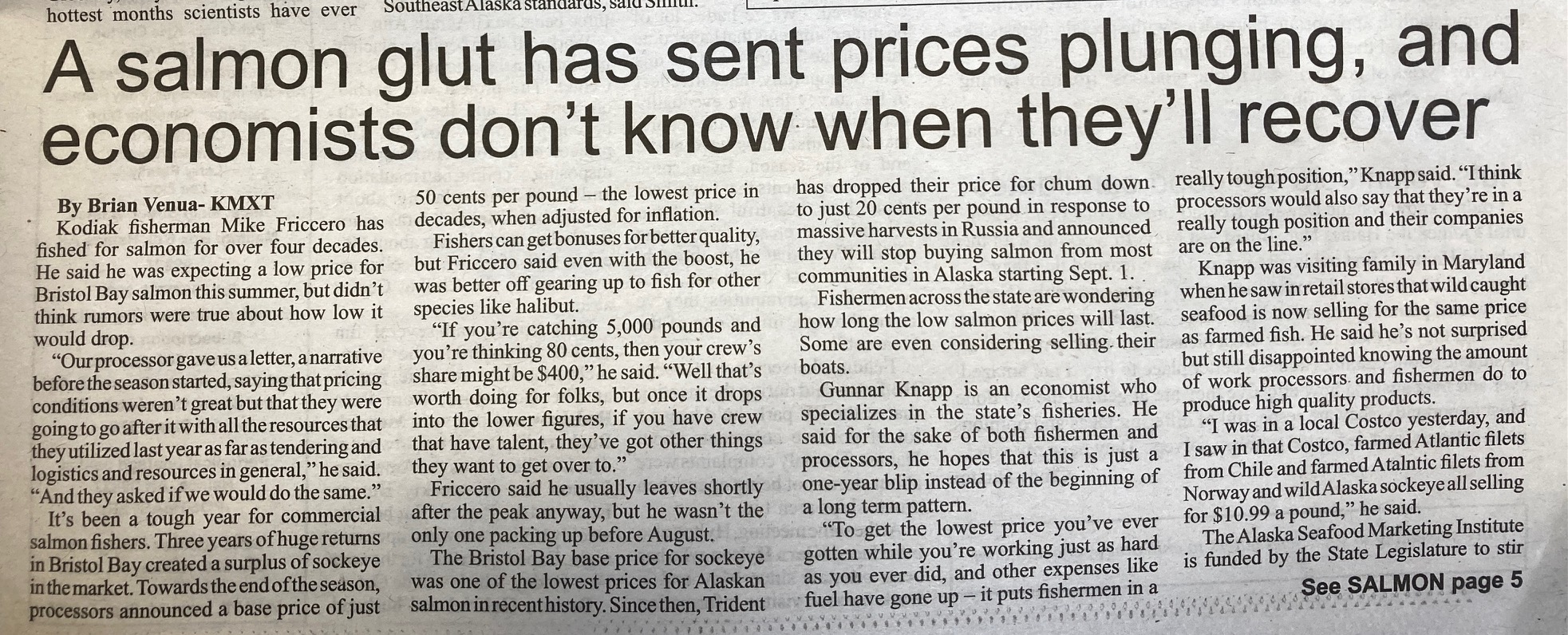
Alaskan salmon management has been so good that there are actually “too many” salmon, if there is such a thing
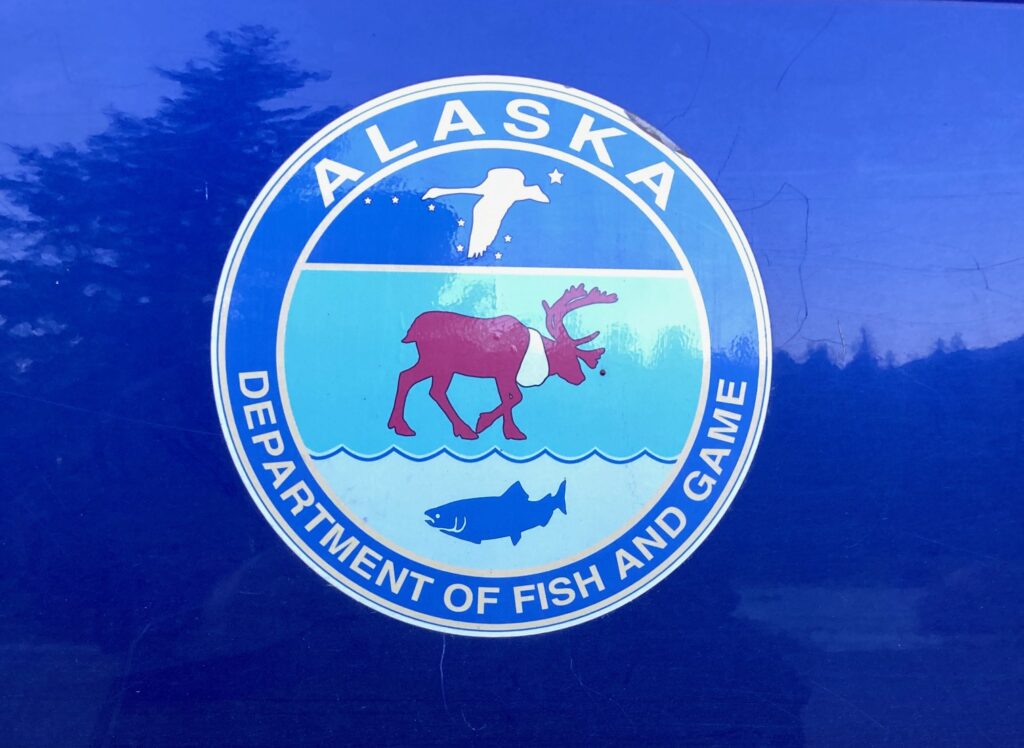
Reflected is the Chilkoot River, where we fished with the bears and a gaggle of international tourists following them up and down the river
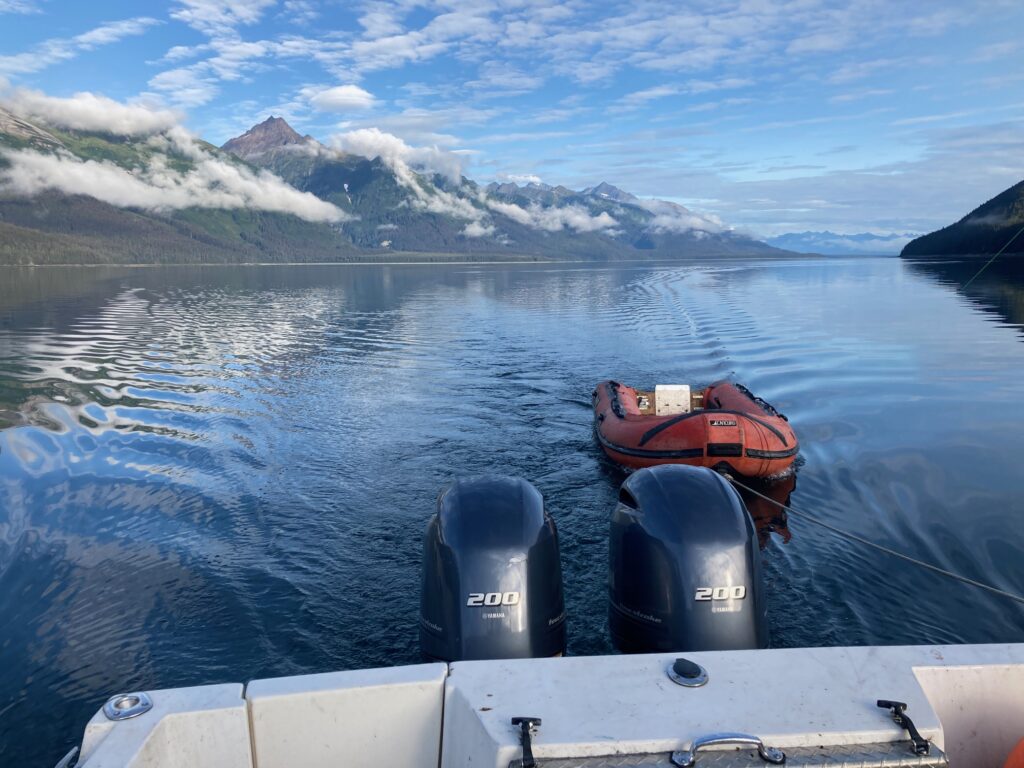
Trolling spoons for salmon, towing our dinghy, and glassing the shoreline for critters. This is hunting and fishing at the same time
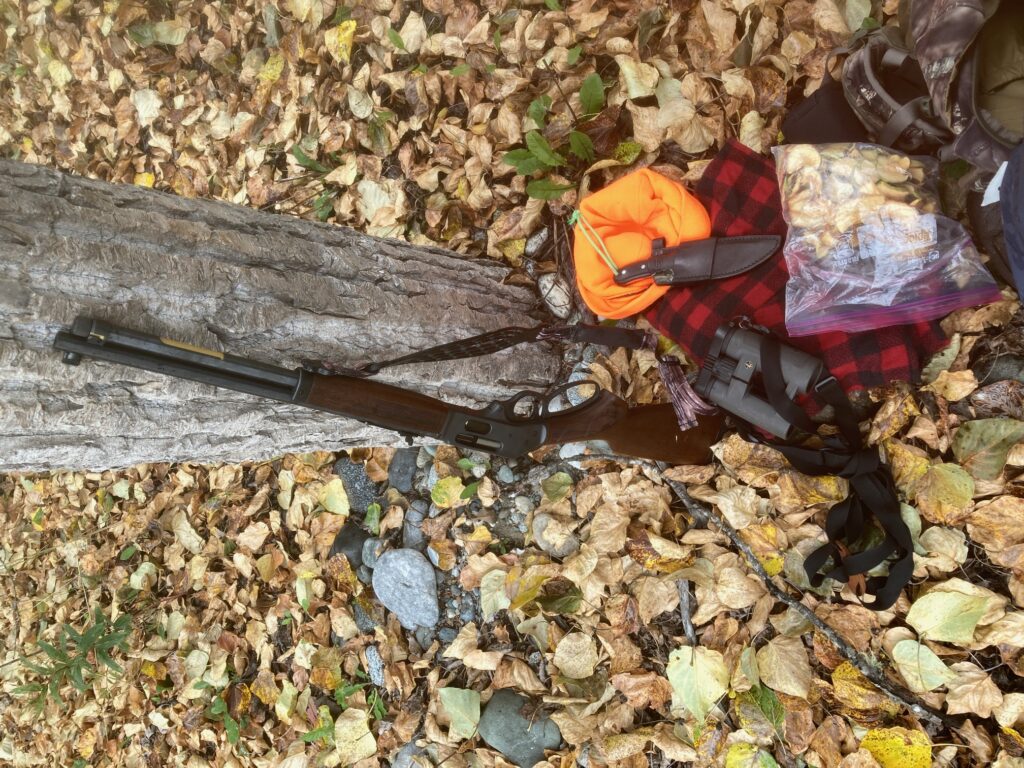
My hunting kit. A Henry 45-70 lever rifle (not crazy about the cheesy rear sight), a JRJ knife, rugged Leupold binoculars, home made dried fruit and jerky
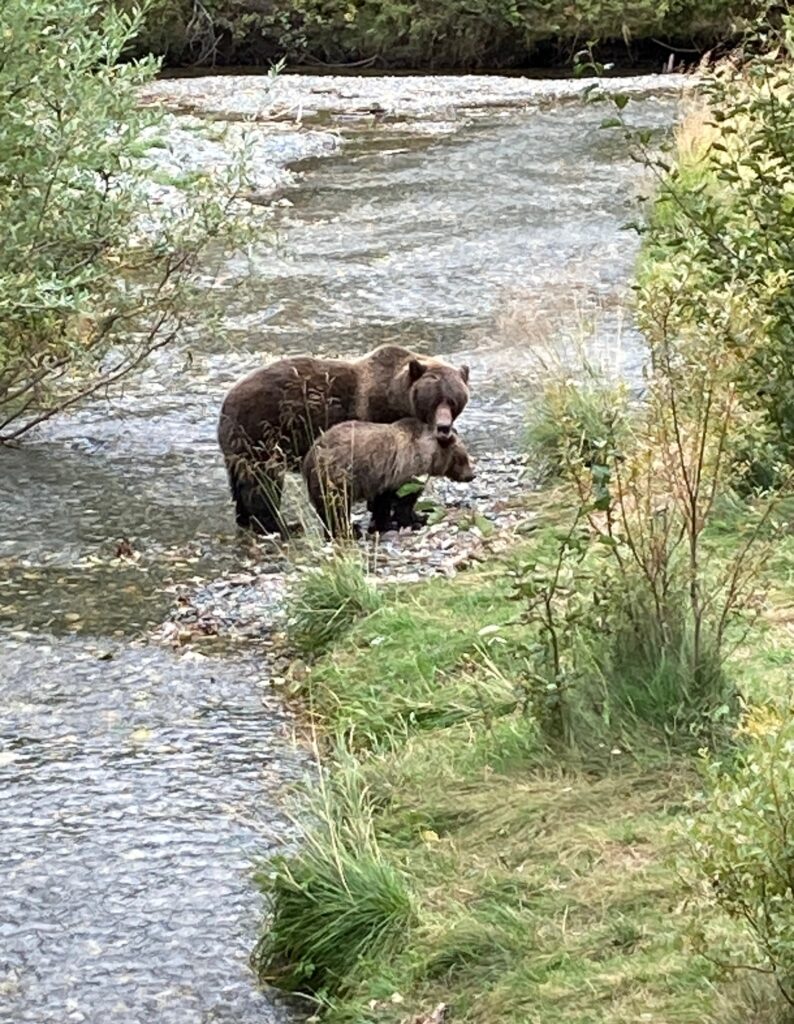
Grizzly sow and cub eating salmon as they spawn upstream from the Chilkat River. I saw a lifetime supply of griz on this trip.
Irv’s summertime camping gear recommendations
Summertime Camping Equipment Review
The good, the bad, and the ugly….maybe
by
Irving Krasnoshtayn, Special Guest at joshfirst.com
When I was a kid, my family did not go camping. There was nowhere to go. The “open space” in Brooklyn, New York, was the little crack between the concrete slabs on every sidewalk where small sprouts of grass grow. Football, hockey, even baseball games were played in the street or in a crowded public park if one was near enough. People in tents were known as homeless. The first time I went camping was with a bunch of college friends over 20 years ago. It was a poorly planned and ragtag experiment, by guys with more spirit than knowledge. We brought an axe and chopped our own firewood, and then thought we were real outdoorsmen. More than anything we all got giant blisters on our soft city hands. Lots of things have changed since then, but my enjoyment of camping only grew from that one fun misadventure.
Fast forward just a few years and now I am the dad with little kids who excitedly ask me about camping over summer vacation. But unlike my childhood, society today is a lot more mobile, and outdoor recreation is a lot more widespread, common, and much more easily accessible. When you have a couple kids and a wife, you have to think not only about the easy, happy family coziness, fresh air, and the sunshine aspects of camping, but also about everyone being comfortable, repelling bugs, people going potty in the middle of the night, and having decent food. Meeting all of those goals with a family means that we get to try out a lot of camping gear, albeit mostly car camping and not always wilderness treks. Our destinations are usually commercial campgrounds and state and county parks. So here’s my honest review of some things I rely on when family camping. I know there are plenty of dads and moms out there who are hungry for this kind of information. Links to many of these items are below.
Tents: I have two tents, each costing around $100. One a six-person and the other an eight-person, both made by Coleman. But those sizes are a lie because each tent fits two people fewer than advertised, especially with all their gear. You have to think about keeping your stuff dry inside the tent in bad weather, so a backpack takes up the space of a person.
These Coleman tents are relatively easy to set up and they have been reliable. But buy a bigger tent than you think you need, unless you will be backpacking it on a mountain. In which case you will want the absolute lightest gear, which is a whole other story. Use strong steel stakes, they don’t bend as easily as aluminum and last longer. I also put down a cheap tarp on the ground slightly larger than the tent, to take off shoes before we get into the tent and to protect the bottom and keep it from tearing.
Sleeping bags: I have owned more sleeping bags than I can count on both hands. This key part of camping has been a long process for me, and I hope you can learn from my mistakes. In the course of learning sleeping lessons while camping the hard way, I have discovered I really don’t like mummy bags. Mummy bags are sold as a common camping cure-all, but they best fit small framed and narrowly proportioned people, while I want room for my tree trunk legs and wide shoulders. Don’t buy a bag from an unheard of company, like I have, while trying to save money; you will end up paying the real price in comfort and enjoyment, which is worth more than money. At the lower end of the price range, say around $40, Coleman makes decent sleeping bags. Some have cotton lining, some nylon, some acrylic, some flannel, but either way make sure you like the particular material against your skin before you walk out of the store with the bag. I have used everything from 20 degree bags to 50 degree bags, and absolutely none are as warm or breathable as they claim. Until you test your bag and understand its real limits, make sure you bring extra base clothing to keep warm at night. A drinking bottle filed with hot water can help overnight. Coleman’s Brazos is a decent model. A stuff sack for storing the sleeping bag short term is great to have too. To preserve their fill loft, sleeping bags must be stored long term either hung up hanging freely, or in large sacks that do not compress them.
Sleeping pads: One of the most important things I have bought for camping is a sleeping pad. I like a comfy sleep, what can I say. Once you sleep somewhere rocky you will understand why a good sleeping pad is important. Besides, I’m getting old and want to be comfortable. Walmart sells a cheap roll up pad like the military uses that is about a half an inch thick, and that is the minimum I would recommend. I highly recommend the best pad you can afford, either closed cell foam or inflatable. I have one for each family member of different types and thicknesses. The egg crate type is not bad but I prefer a firm type made of open/closed cell foam.
I own a few self-inflating pads but I’m afraid they might develop a hole and deflate like happened to me once. I like reliability, which the closed cell foam has.
Pillow: When camping with our car, we bring our pillows from home. When backpacking I take one of two inflatable pillows, but some people just bring a pillow case and stuff it with their clothing. That works.
Fire: Although I own many axes, such as the decent Cold Steel axe, I now rarely use one while camping. Instead I use a few different saws to get my firewood. Silky saws of Japan makes the best saws money can buy. The Silky Gomboy with medium teeth is the most comfortable and fastest cutting saw I know of besides using a chainsaw. Their teeth are wider than the spine so they cut very well and don’t bind. They are a pleasure to use but have been known to snap if used forcefully. Take your time and let the saw do the work. They can be found on sale for around $40 and like all good kit, are well worth it. Get the largest one you can afford. “Project Farm” of youtube fame recommended another couple of saws. I will be “real world” testing them soon.
Fire Starting: This is something I have practiced extensively and have found campers need to carry more than one way to start a fire, and know how to use each one. Yes, Bic lighters are a go-to but when it is freezing, snowing, or raining they may not work. Always carry your Bic/gas lighters on your person in a pocket, and NOT in your pack. The reason is your body will keep the lighter warm and the contents in a fluid and flammable state. If the lighter is really cold, the butane will not turn into a gas when you try to light it and it won’t work. Zippo lighters are okay as long as they don’t get wet or leak.
Wind is another reason I don’t rely on gas lighters or survival matches. If you do buy survival matches, make sure the container is waterproof and they are the type that can stay lit underwater. Yes they make those. I used a waterproof pill container filled with LIFEBOAT matches and cotton balls for my kids.
I have made videos throwing every type of lighter or match into a half foot of snow or a bucket of water, and the only thing that was reliable was a Ferrocerium rod. Known as a Ferro rod, I now buy them in bulk and make handles for them out of spent rifle cases. Use the spine of your knife and you will make all the sparks you need to start a fire.
At home I prepare a few cotton balls dipped into Vaseline, and store them in a small Ziploc bag. They have the added benefit of protecting your skin/hands. A Ferro rod will light one immediately and the Vaseline in it will burn for a good minute or two, if not longer. I will sometimes make feather sticks which a Ferro rod will also easily light if done correctly. I own magnesium fire starters, and they work, but they aren’t necessary. Again if it’s windy, the magnesium will often get blown away. Some people like to use military trioxane, but this extra expense is not necessary.
Camp chair: Bring a chair for each person if you can. This is advice that is easy when car camping and very difficult while backpacking. I have not yet found a lightweight folding chair that I like.
Cooking: I have spent hundreds of dollars on a titanium stove and the latest everything else for cooking, and have concluded just a few items are all I need to cook good food while camping. Stanley makes a $30-$40 frying pan kit which is worth it. Titanium frying pans which I own are lightweight but develop hotspots that then cook unevenly. The Stanley frying pan kit cooks everything evenly and comes with two plates, and a take-apart spatula that is almost priceless. Stanley also makes a few other kits including a pot kit and a mug/cup kit which are also very good. I have used them all extensively, and they develop a blackened bottom with open fires. Someone scientifically tested blackened pots and it will boil water approximately a minute faster because it absorbs the heat better. I have a lightweight folding stainless steel grate for chicken, hot dogs and burgers. Works great. I like a titanium cup for quickly boiling water for making tea or a ramen type meal. Lightweight Titanium spoons and forks are also worth buying. Better than any plastic.
Stoves: I like and own many packable wood stoves. The Solo stove is GOOD. It burns wood very efficiently and fast. Sometimes too fast, so you will need a lot of twigs on hand because it doesn’t hold much and you have to keep adding to keep the fire going. Esbit stoves don’t heat up enough for my liking and alcohol stoves might work, but I don’t want to carry alcohol that I can’t drink. Firebox makes quite possibly the best balance of reliability, compactness, yet high capacity wood burning stove on the market. It is amazing and I highly recommend it. The Firebox Nano model is tiny yet unfolds large enough to cook a morning meal without any fuss.
Cooler: I prefer hard sided coolers, because they keep their shape and hold ice overnight, even in the hottest summers. They also repel the sharp claws of raccoons.
Lighting: You will need to see when it gets dark. I prefer headlamps over flashlights because they keep both hands free. I bring one for each person, even the kids. I give out glow sticks just to see where other people are. Any headlamp over 200 lumens is good. Wide beams are more useful for close range. In my work as an electrician, I use headlamps every single day. The cheaper brands have always failed me because they use cheap circuitry and switches that eventually fail just when you need them most. Energizer makes many excellent headlamps.
Eveready makes a good model for $10. On the higher end, Petzl, Streamlight, Black Diamond, Fenix, Surefire and many others make very good lights. Don’t buy a crappy light, because you don’t need to. The good ones don’t cost much more than the really bad ones. I don’t use rechargeable batteries when camping, because unless you have solar panels how are you going to charge it? I’m not going to carry a battery power bank. I bring an extra set of fresh batteries. [Editor’s note: I have used two different Anker solar chargers on long distance ten-day backpacking trips and they work well when matched with the right battery – JF]
Rope: Buy some paracord and keep it in different places where you might need ten or twenty feet of it. Home Depot sells a decent paracord. The brighter colors are better, because your eye will see them and stop your feet before you trip over them when they are guyed out around a tent or a tarp shelter. Also useful for tying down your stuff in strong wind.
Duct Tape: I like gorilla tape. It sticks better than any duct tape I have ever used. Wrap a few feet around something like your lighter.
Multitool: I prefer Leatherman. The wingman model has scissors, a pocket clip, and is relatively light.
And finally, knives: Few outdoor items are more iconic or representative of camping than a fixed blade knife or one of the newfangled, robust, easy-open folding knives. Everyone has different sized hands and skin, so everyone prefers a different handle material and shape, and thicker or thinner, longer or shorter. There are so many knives on the market, I should begin by telling everyone to always carry a pocketknife. Preferably one with a locking mechanism so it doesn’t accidentally close on your fingers. Swiss army knives are OK for home use, but I don’t prefer them as a daily pocket carry.
Fixed blades are also necessary. I’ll start by recommending the least expensive of the bunch, Mora knives of Sweden. They are the best bang for your dollar at the moment. I recommend stainless steel over carbon steel so that your knife won’t rust, and if there is one thing you are guaranteed of on a camping trip, it is that your knife will get wet and it won’t get put away dry.
At around $20, the Mora companion model is a great knife for many reasons. It has a comfortable handle and an excellent sheath which clips onto your belt without you having to take it off. Mora uses a Scandinavian grind on their knives, which is excellent for “Bushcraft” type work, which is a variety of light to heavy utility work, plus food preparation. I prefer full flat grinds which are much more versatile, particularly for food preparation.
ESEE knives have an unconditional lifetime guarantee. They come in 1095 high carbon steel which may rust if not cared for. (Use vaseline from the cotton balls or plain mineral oil to prevent rust)
I used the ESEE 4HM model (~$120) for an entire camping trip and found it excelled at everything. GREAT knife.
In the Outdoors, the sheath is just as important as the knife.
First Aid Kit: Always carry some type of first aid kit and know how to use it. I was an EMT, and based on my experience I think everyone should at least learn the basics. Know how to stop bleeding with pressure or how to stabilize/support a sprained ankle. Accidents happen, be prepared, and having a good first aid kit is step one in being prepared. Car camping first aid kits can be almost like a mobile field hospital in size, and backpacking first aid kits must be streamlined and geared towards treating foot blisters, burns, and knife cuts.
I put together my own first aid kit in a one- gallon waterproof Ziploc bag, including everything from Band-Aids to gloves and gauze to common medications like ibuprofen and aspirin.
Have a great summer camping with your family!
LINKS:
tents:
sleeping bags:
| Coleman Green Valley 30°F Cool-Weather … |
sleeping pads:
Foam Sleep Pad- Extra Thick Camping Mat for Cots, Tents, Sleeping Bags & Sleepovers
Saws:
Silky GomBoy Professional Folding Saw 240mm Medium Teeth (121-24)
| Silky GomBoy Professional Folding Saw 2… |
Samurai KISI FC-240-LH / 9 1/2″ (24cm) Folding Curved Blade Saw Made in Japan
| Samurai KISI FC-240-LH / 9 1/2″ (24cm) … |
Fire making:
Cooking: pots pans
Stoves:
| Lite Camp Stove | Solo Stove |
|
Headlamps:
Knives:
ESEE 4HM Fixed Blade Knife w/ Kydex Sheath & Micarta Handle
| ESEE 4HM Fixed Blade Knife w/ Kydex She… |
Diana Archer saves my brain from Exploding
Across America brains are either exploding or are on the edge of it.
Mine is on the edge of exploding, because I was expecting an honest election result two weeks ago. You know, where my preferred candidate successfully barnstormed the swing states and generated big results. Instead, the election experienced tremendous voting irregularities, outright open fraud, political interference, and a clear effort to spam the whole process with such an overwhelming number of fake ballots and fraudulent counting that clearing the whole mess up will take a herculean effort. It did not matter that my preferred candidate had worked his ass off, had taken many risks and worked himself tirelessly to persuade an unusual mix of new and old voters to support him.
Instead, what awaited my preferred candidate after Election Day was a slew of fake voting machines that have been tampered with, fake ballots, fake ballot counting with no transparency etc etc across eight states, and a fake media that was pre-pared (like prepared to be prepared) to immediately anoint his opponent the winner, regardless of the actual outcome.
Fake it til ya make it and then election by media acclaim is what has been attempted against my candidate. It is infuriating, because it runs contrary to everything America is about.
Making the post-election period worse than the actual fake tallying process already was, is the mainstream media and Big Tech effort to censor and suppress information contrary to their narrative that Joe Biden won and is now the President Elect. It is one thing to go to bat for an ancient 47-year career politician who is corrupt and senile. It is another thing altogether to try to hide not only his corruption but also the fake election that he “won.”
Interesting that Biden did not win any down-ballot elections across America, almost all of which (98% I think) went for his opponents….no, no predicted “blue wave” happened…Biden just happened to win the “big one.” In real elections, this does not happen, because all of the real votes are correlated with various other candidates, and not just the presidential race. This is Exhibit A in the vote tampering argument.
So those of us addicted to the simple idea of a fair-and-square transparent election have had our heads exploding for two weeks. We cannot believe the unashamed, scandalous behavior that is happening in front of our eyes, what is really an illegal attempt to hijack an entire nation.
While I could sit at my computer and stare wild-eyed into my iPhone as the 1,440 minutes slowly tick by each day that this scandalous process unfolds, like so many friends are doing, I have decided to remove myself from this tense situation. Instead, a lady named ‘Diana Archer’ is taking me out into the woods and fields, where we are going to contemplate life, love, being a balanced human being, etc. I need this time to regain some inner balance that has been thrown askew, and I think about 75-million other voters probably feel the exact same way. Fortunate me that I have Diana to take my hand and lead me on.
To be explicit, Diana Archer is really Diana The Archer, the Goddess of the Hunt. As hunting season has now arrived full force, from deer to bear to ducks to doves, the whole east coast is alive with clandestine rural life, all led by Diana.
With Diana at my side, I intend to sleep snugly in my Seek Outside tent, using its titanium stove to keep warm at night, to boil tea in the mornings, and to dry out inevitably wet clothing. During daylight hours Diana will hopefully be by my side, helping me get into a kind of Thoreau-Wilderness-Zen mindset, where nothing can trouble me, and I become at one with the natural rhythm of Mother Nature and the rifle in my hand. And no, there is no scandal in this pure woman’s company, just the spirit of the hunt, which is often just the hunt for the spirit.
So, see you all in a bit. Forgive me if I am not glued to this computer screen, but am escaped, at least for a healthy while.
One call I won’t take
Phony, fraudulent telemarketer calls are super annoying, and like you, I am fed up with them.
Another phony call just arrived, called “Call of the Wild,” a new movie loosely based on a Jack London book by the same name.
Jack London’s stories of tenuous life in the Yukon and Alaskan interiors are the stuff of pre-internet American boyhood. Just like coonskin Davey Crockett hats were all the rage among American boys in the 1950s and 1960s after Fess Parker starred in the same-named TV show, so too did London inspire many young men to get their forestry degree, build a canoe, cut down their grandmother’s favorite apple tree with a hatchet, or move to Alaska. His stories of nail-biting survival and creeping or sudden death in the boreal forests and frigid back country rang true, and a number of movies have been made about them. Some better than others, but all of them pretty good just because the story line is great.
London’s story about a young man caught at sundown in the winter time Alaskan bush, unprepared for the minus-forty-degree night, who gets down to his last match and finally succeeds at lighting a life-saving fire, only to have the snow from the branches above fall and smother the fire, is classic.
This latest iteration involves an unrealistic CGI human-like dog that giddy un-wilderness urbanites will fawn over. It also includes Harrison Ford, a man blessed with poor acting skills who nonetheless has landed a huge list of Hollywood roles and who made a huge pile of money. Play acting and playing dress-up; not exactly brain surgeon level or even bank teller level stuff.
And to be fair, Ford’s best movie roles are those that fit his kind of simple, bland, taciturn persona, like the Jack Ryan character, or Indiana Jones, or the emotion-less Blade Runner cyborg cop. Or those roles that are actually enhanced by his lack of acting skills, like Star Wars‘ Han Solo. Whenever Harrison Ford is tasked with actually acting, his lack of nuance or depth shines through bright and shiny. One suspects that this Call of the Wild will be one such role and performance. Or maybe not, because the 2020 movie poster for it shows Ford looking all serious and taciturn.
Now, because I am a wilderness hunter, fisherman, and trapper, any new movie like Call of the Wild immediately gets my attention. Bad acting or no, evil corrupt anti-America Hollywood or no, CGI human dogs or no, it is a movie I would naturally be inclined to go see. It is about nature and outdoor adventure, my favorite things. However, Harrison Ford finally performed honestly the other day and thereby blew up any chance of me seeing his film, and probably many other people feel the same way.
Last week, Ford appeared on not-funny Jimmy Kimmel’s late night show, and blasted Preident Trump, calling him “a son-of-a-bitch.”
Out of nowhere, and for no particular reason. Other than pandering to Hollywood.
What a shame, because at one time Ford was a spokesman for Conservation International, a worthy environment protection organization. His other opinions about so-called climate change and carbon reduction are the usual Hollywood hypocritical hilarity, because Ford is also the guy who flies his own plane on a 400-mile round trip to get a single hamburger to satisfy his craving for fast food. Talk about a carbon footprint, and yet his lecturing never ends.
Now, everyone is entitled to their opinions, and like Ford, I am entitled to mine, too. And my opinion is that I will not support with movie ticket purchases those celebrity Hollywood actors who insult me, my values, my lifestyle, or the people I vote for. So I will not be answering Harrison Ford’s Call of the Wild. Though I might play it on one of the many black market bootleg websites, just so I can take from Ford a tiny bit of what Ford took away from me: A good feeling.
Below is just one video of Harrison Ford actually whining about his wild success, as if it ruined him as some sort of serious artiste. Oh please. Ford is just another out of touch, spoiled rotten Hollywood jerk. Where is comedian Ricky Gervais when we need him most? Every Hollywood actor like Harrison Ford should have to spend a week with Gervais following him or her everywhere they go, commenting on their vapid lives and stupid statements.
It’s that time of year again, Pt. II
It is now “that time of year again,” but Part Two.
A month ago your firewood had better have been laid up and close to perfectly dry, or you were going to have an uncomfortably cold winter in rural America.
Now, a month later, a whole bunch of hunting seasons are upon us. Small game, trapping, deer archery, bear archery…and many people are afield a serious amount of time. Some people try to catch the deer rut in a couple different states with their bow. It can become a crazed time, where the humans are just as worn down and rutted up by the prospect of catching unawares a big old wary buck who, in his brief moment of annual craziness, lets down his guard.
Usually, I do not begin trapping in earnest until December, when all pelts are truly prime and when the bobcat and fisher seasons begin. Early on I set out cage traps to thin out the skunks and possums that will otherwise clog up my best sets later on. Never one to sell furs, trapping for me has always been about helping ground-nesting birds against an overabundance of nest-raiding mammals pulsing out from suburban sprawl habitats. With Russia and China in bad financial and economic situations the past five years, wild fur has not been in as big demand as the past. This lower demand has led many professional trappers to abandon their lines and wait for prices to come back up. In turn, that let-off in trapping pressure results in TONS of raccoons, possums, skunks etc running around. Over the past couple of weeks I have seen more road-kill raccoons than in many years past all together.
And this high population of raccoons means higher rates of rabies, trash-raiding, fights with pets, etc.
My favorite type of hunt is the solo wilderness excursion. Sleeping in a cold tent, bundled against the night time freeze, waking up to some snow on everything, enjoying a hot tea to start the day, and wandering into the wind, trying to find buck or bear tracks. Or in the case of a big male bear, making sure he isn’t on my track, like two years ago.
Is there danger in this? Sure. Then there is danger in being hit by a car, or falling and damaging a body part. There is danger in never experiencing life, and thinking that the modern risk-free cocoon most of us live in is either normal or healthy. It is neither.
And so it is that time of year again, when every fiber in my body says “Get outside, NOW!” It is a time of forgotten or deliberately misplaced professional obligations, phone calls returned on a Friday afternoon, instead of the prior Monday morning. I hope friends and colleagues will forgive me if I am a little late in getting back.
Nature is calling on the phone, it’s for me, and I gotta run.
I’ll be back. Promise.
The Importance of Wilderness
Wilderness rarely makes it into the news.
It usually gets mentioned when a US president designates a new wilderness area, or adds existing federal land to an existing wilderness area. The acreage involved in those events is so large, usually so vast, that it must be newsworthy. It just has to be news. It is impossible to ignore it.
This makes the “very good” news.
Another way to get wilderness into the news is to raise the subject of natural resource management in a remote area that is not declared or designated wilderness, but which has a wild and untouched character. These reports are usually cast as a loss of innocence, a loss of wildness, a loss of something special.
This makes the “very bad” news.
Wilderness as a news topic usually involves one extreme or the other: Very good, or very bad.
The truth is that wilderness, those huge untouched areas with nothing but healthy flowing watersheds, breathing forests, and nearly unlimited wildlife habitat, are of mere flesh and blood. Wilderness gets such short shrift and limited coverage in the news media, because so few people know what it is. It is mythologized for better and worse. That it is nearly 100% public land can complicate things, politically, but the fact is, you will not find wilderness in any other state of being in a developed nation.
Most Americans do not have any real exposure to actual wilderness. Their hands-on exposure to it is either zero or merely driving through or around some wilderness area or region (like northern Maine), and admiring it from a car or picnic area. Few immerse themselves in it.
For me and for many people like me, wilderness is like oxygen. We just have to have it. We must have it coursing through our bodies, supporting our feet as we stand or hike or explore. There is nothing mystical about this experience. No transformative or spiritual worshipfulness. No beams of sunlight directed downward by heavenly forces. It is a purely physical connection that in the context of modern sedentary lifestyles becomes such a stark contrast and unusual experience.
Oh sure, we see the hand of God in Nature. Goes without saying. How can you not see Him there? The genius of life on Planet Earth is beyond magical, beyond scientific.
That I get an endorphine rush from every moment I am out in wilderness is an indication of my own “nature deficit disorder,” a topic worthy of a full discussion some other time and something most assuredly suffered by the vast number of Americans.
Why people do drugs of any sort is beyond me, because I can get a safe and natural high from watching a tree sway in a breeze, or a snowy hilltop dressed in silent snow, or a tiny junco flitting among the snowy branches of a small spruce tree. So much of what we call wilderness is really just the same things going on in your own back yard, except that actual wilderness has much less of some of that animal activity, and a lot more silence and serenity. In designated or de facto wilderness, we do see the more rare and cool “charismatic” animals, like moose, panthers, fishers, bobcats, marten.
As an experience, for wilderness lovers like me, wilderness excursion or immersion is just like eating, or breathing. Its quiet is a quantifiable value, like a gallon of gasoline has a price we pay to keep our vehicles going. People like me simply gotta have that wilderness experience to keep running. In modern American terms, it is like having a really big house. We feel like we belong and must be there, comfy and snug.
One of the challenges with wilderness designation is that most of it happens out West, where there are already hundreds of millions of acres of nationally-managed public lands. Already out there are big wilderness areas that a person could spend an entire summer exploring just one location.
Back East we have hardly anything resembling wilderness, and what we have is easily degraded. It is here in the East that the energy and money must be focused on setting aside wilderness while we still have some few opportunities remaining. Opportunities being those industrial lands no longer useful for commercial forestry or mining.
It is a lot more politically palatable to work on wilderness protections here, in the East, where the majority of the American population is concentrated. Many more people are excited about it here, and far fewer people feel like their livelihoods will be negatively impacted by public land and wilderness. Because we have so little of it.
Wilderness is important because it is in wilderness that our species evolved and lived happily for 99% of our time on Planet Earth.
Wilderness is our natural state of being, where we humans are most at home, most honestly, naturally ourselves. In modern times, it is where we are least distracted by “narischkeit,” meaningless chatter and buzz. In wilderness we can be honest, true, most mentally healthy, if only for a day or two.
This past Fall I killed the biggest bear I have ever seen in the woods, in a designated Adirondack wilderness area where I was on a solo hunt. It weighed close to 600 pounds, and its hide squared over six feet. Its hide is literally over twice the size of the 260-pound bear’s hide I sleep under in the winter. A true monster. The king of the mountain.
Know what’s neat about this hunting experience? This bear had probably never seen a human before, and he stalked and tried to eat me three times. The third and last time he tried was when I lost patience amidst growing fear that I was going to be eaten alive, and I shot him at thirty yards in the middle of absolutely nowhere. Just skinning him took almost two days, because his enormous carcass rolled under a log on a steep hillside.
It was predator versus predator, animal eating (or wearing) animal, the most basic natural law on Planet Earth.
Though I admit feeling remorse for having ended his kingly reign. I had been after a big buck, and only took my foe when he had willingly forfeited his nine lives over the course of two days with me on the mountain.
I have never felt so alive.
Wilderness, it’s in us. It is important to us, to be us.
To be human.
On Being a Dinosaur
I am a dinosaur.
In so many ways, my beliefs, ideals, values, education, outlook, hobbies, lifestyle, and behavior seem as outdated and as uncommon as the dinosaurs that died out long ago.
Put another way, I am one of the Last of the Mohicans, certainly not THE last, but one of a dwindling group that sees the world differently than the corrosive pop culture fed daily to Americans by Hollywood.
And I am proud to be this way, to be a patriot, to exalt individual citizen rights and liberties above government intervention, to take risks and make sacrifices in a free market capitalist society that rewards hard work and penalizes laziness. American Sniper, Act of Valor, and Lone Survivor are the only movies that moved me in many years because I believe in military heroes, although the Lord of the Rings productions are highly entertaining.
Meanwhile, pop culture would have every American equally unhappy, equally deprived of their rights and liberties, equally planted on a couch eating junk food and watching mindless TV shows that are at war with the underpinnings of Western Civilization.
(A short, hard-hitting article about Hollywood’s destructiveness by one of its most famous writers is here.)
And I am also an old-fashioned “Hook-and-Bullet” conservationist, a hunter, life-long gun owner and fisherman, an NRA member and even more so, a FOAC member who means it when I say “You can have my guns when you pry them from my cold, dead hands.”
But did I mention that conservation is a huge part of my identity? You know, farmland preservation, wildlife habitat protection, forest land acquisition for public ownership, and wilderness areas where I can hunt, fish, camp, and hike without seeing or hearing another human being for as long as I am out there.
And why is it so hard for so many traditionalists to see that traditional American values are directly tied to, and derive from, rural landscapes? And that our remaining rural landscapes are precious fragments of the great American frontier, on which our national identity and Constitution were forged?
So why wouldn’t a conservative want to conserve those rural landscapes that gave birth to his identity and values, that enshrine Constitutional rights and self-reliance?
For some strange reason, an increasing number of gun owners are not hunters, and do not really show that they care about wildlife populations or wildlife habitat, or about land and water conservation. When I attend meetings at different sportsmen’s clubs, like Duncannon Sportsmen, and I hear the Conservationist’s Pledge, my heart wells up and I nearly get as teary-eyed as when I hear the national anthem, or the Pledge of Allegiance. It doesn’t help that most of us in the room are sporting lots of white in our beards and on our heads. The next generation seems to have taken a lot for granted, because all of the battles we fought decades ago bore such abundant fruit.
All this makes me a dinosaur, and although I recognize it, I am not happy about it. I feel like I am watching the greatest nation on Planet Earth disintegrate under my feet, and it scares me, makes me sad, and makes me want to do what I can to try to prevent it from happening.
I do not want traditional American values to go extinct, like the dinosaurs, because although those values may not be in vogue right now, America was founded on them and the nation cannot successfully continue on without them.
Fifty years of designated wilderness
Two weeks ago marked the fiftieth anniversary of the signing of the Wilderness Act.
It applies to federal designation of remote areas, not to states. States can create their own wild areas, and some do. States closest to human populations and land development seem to also be most assertive about setting aside large areas for people and animals to enjoy.
I enjoy wilderness a lot. Hunting, camping, hiking, fishing, and exploring are all activities I do in designated wilderness.
Every year I hunt Upstate New York’s Adirondack Mountains, in a large designated wilderness area. Pitching a tent miles in from the trail head, the only person I see is a hunting partner. Serenity like that is tough to find unless you already live in northern Vermont, Maine, Montana, Idaho, Wyoming or Alaska. It’s a valuable thing, that tranquility.
This summer my young son sat in my lap late at night, watching shooting stars against an already unbelievably starry sky. Loons cried out all around us. A gentle breeze rustled the leaves on the birch trees above us and caused the lake to lap against our rocky shore.
Only by driving a long way north, and then canoeing on a designated wilderness lake, and camping on a designated wilderness island in that lake, were we able to find such peace and quiet. No one else was anywhere around us. We were totally alone, with our camp fires, firewood chores, fishing rods, and deep sleeps in the cold tent.
These are memories likely to make my son smile even as he ages and grapples with responsibilities and challenges of adulthood. We couldn’t do it without wilderness.
Wilderness is a touchstone for a frontier nation like America. Wilderness equals freedom of movement, freedom of action. The same sort of freedoms that instigated insurrection against the British monarchy. American frontiersmen became accustomed to individual liberty unlike anything seen in Western Civilization. They enshrined those liberties in our Constitution.
Sure, there are some frustrations associated with managing wilderness.
Out West, wilderness designation has become a politicized fight over access to valuable minerals under the ground. Access usually involves roads, and roads are the antithesis of a wild experience.
Given the large amount of publicly owned land in the West, I cannot help but wonder if there isn’t some bartering that could go on to resolve these fights. Take multiple use public land and designate it as wilderness, so other areas can responsibly yield their valuable minerals. Plenty of present day public land was once heavily logged, farmed, ranched, and mined, but those scars are long gone.
You can hike all day in a Gold Mine Creek basin and find one tiny miner’s shack from 1902. All other signs have washed away, been covered up by new layers of soil, etc. So there is precedent for taking once-used land and letting it heal to the point where we visitors would swear it is pristine.
Out East, where we have large hardwood forests, occasionally, huge valuable timber falls over in wilderness areas, and the financially hard-pressed locals could surely use the income from retrieving, milling, and selling lumber from those trees. But wilderness rules usually require such behemoths to stay where they lay, symbols of an old forest rarely seen anywhere today. They can be seen as profligate waste, I understand that. I also understand that some now-rare salamanders might only make their homes under these rotting giant logs, and nowhere else.
Seeing the yellow-on-black body of the salamander makes me think of the starry night sky filled with shooting stars. A rare thing of beauty in a world full of bustle, noise, voices, and concrete. For me, I’ll take the salamander.
